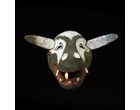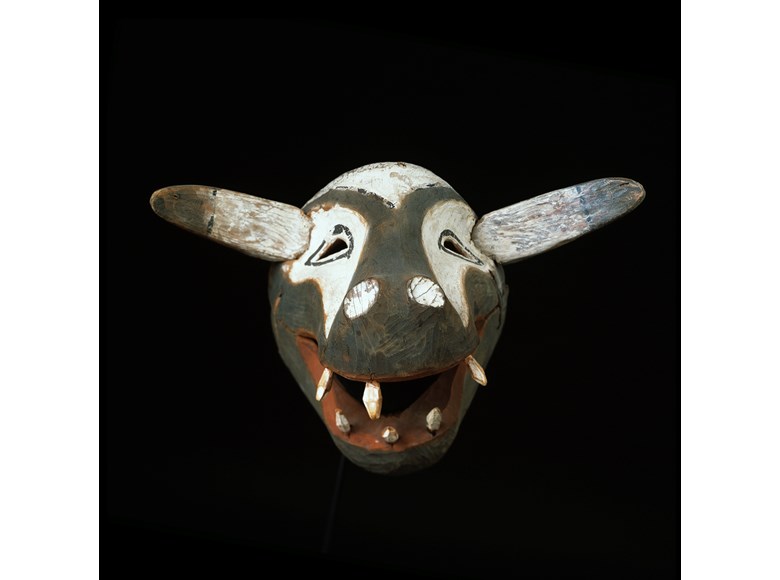 BACK TO GALLERY
BACK TO GALLERY
Tambaran
ESKIMO MASK depicting a wolf or a bear’s head
ESKIMO MASK depicting a wolf or a bear’s head
Anvik, Alaska
Wood, pigments
D: 8 ¼” L: 12 ½” (ea
D: 8 ¼” L: 12 ½” (ear to ear)
description
Angalik Wooden Wolf Mask in the lower Yukon region of Alaska
This lively face mask represents a wolf and was used in dances to honor the animal spirits, held annually during the winter cycle of ceremonies.
The face was carved from two separate pieces of wood, joint together at the jaw. The original ears and teeth attachments are projecting outward, giving the mask a whimsical appearance.
Polychrome pigments to animate the facial features, startling white patterns outline the pierced triangular eyes, delineate the nostrils and light up widely spaced teeth in a mocking smile.
The neighboring Indian settlements of Anvik, Holikachuk, and Shageluk in the lower Yukon region were closely bound by the series of annual mid-winter ceremonies held in each community to which residents of the other two were often invited. These ceremonies involved feasting, ceremonial exchange, gift giving, and dancing. This tradition was probably influenced by the Inuit Eskimos who held a similar feast and ritual cycle during the winter freeze.
The focal point for community life in the winter Ingalik villages was the kashim or ceremonial house, which was used primarily used by men and was the location of religious and secular ceremonies. The mask was probably used in the Animal's Ceremony, considered the social highlight and open to all, with skits, masked dancing and feasting that continued for 2 to 3 weeks. This event also had the serious purpose of entreating the animals to return and ensure environmental harmony in the coming year. Animal masks were also danced in two other ceremonies performed in the cycle: the Mask Dance and the Bladder Ceremony.
This lively face mask represents a wolf and was used in dances to honor the animal spirits, held annually during the winter cycle of ceremonies.
The face was carved from two separate pieces of wood, joint together at the jaw. The original ears and teeth attachments are projecting outward, giving the mask a whimsical appearance.
Polychrome pigments to animate the facial features, startling white patterns outline the pierced triangular eyes, delineate the nostrils and light up widely spaced teeth in a mocking smile.
The neighboring Indian settlements of Anvik, Holikachuk, and Shageluk in the lower Yukon region were closely bound by the series of annual mid-winter ceremonies held in each community to which residents of the other two were often invited. These ceremonies involved feasting, ceremonial exchange, gift giving, and dancing. This tradition was probably influenced by the Inuit Eskimos who held a similar feast and ritual cycle during the winter freeze.
The focal point for community life in the winter Ingalik villages was the kashim or ceremonial house, which was used primarily used by men and was the location of religious and secular ceremonies. The mask was probably used in the Animal's Ceremony, considered the social highlight and open to all, with skits, masked dancing and feasting that continued for 2 to 3 weeks. This event also had the serious purpose of entreating the animals to return and ensure environmental harmony in the coming year. Animal masks were also danced in two other ceremonies performed in the cycle: the Mask Dance and the Bladder Ceremony.






 SEND AN EMAIL
SEND AN EMAIL
 (212) 570-0655
(212) 570-0655